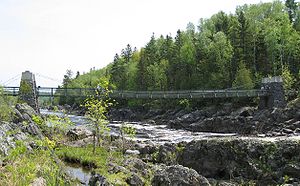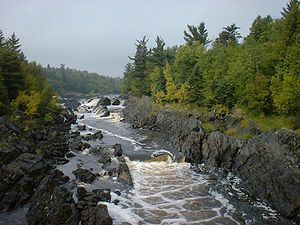
Jay Cooke State Park
Encyclopedia
Jay Cooke State Park is a Minnesota
state park located about ten miles (16 km) southwest of Duluth
, just outside the small town of Thomson
. Jay Cooke is situated on the St. Louis River, which enters into Lake Superior
through the Duluth/Superior Harbor, so it is considered by many to be the southernmost of the Lake Superior State Parks.
financier
Jay Cooke
, who had developed a nearby power plant, which is still in use. The park remained generally undeveloped until 1933, when a Civilian Conservation Corps
(CCC) camp was established on the site. The CCC camp built a rustic swinging bridge over the St. Louis River just slightly downstream from some torrential rapids and waterfalls. This camp also built a picnic shelter. The camp was disbanded in 1935, but a second camp was set up in 1939. This camp rebuilt the swinging bridge and built the River Inn, which now houses the visitor center. This camp was disbanded in 1942, shortly before the federal government ended the CCC entirely. In 1945, the state began to add more land to the park, eventually giving it its current size of 8818 acres (35.7 km²).
or gabbro
stone and dark planks and logs. Most famous of all landmarks is the swinging bridge, which is one of only two suspension bridges in any Minnesota state park. The bridge was designed by Oscar Newstrom and built by the CCC. It runs 200 feet (61 m) long, 126 of which run over the river itself. It is supported by two large concrete pylons also faced with gabbro. The bank of the river near the River Inn is too steep to walk along, so anyone who wishes to hike the length of the river generally must cross this bridge.
Three districts of the state park are in the National Register of Historic Places
. These districts are the Rustic Style District, including the River Inn and Swinging Bridge; the Picnic District, including the shelter, water tower and latrine, and drinking fountain; and the Service Yard District, including the custodian's cabin and pump house.
. The bedrock is largely composed of slate
and greywacke
. The river washed away the red clay topsoil and caused this bedrock to become exposed. Underground movements also caused the bedrock to bulge and break, making large protrusions of shale
, often at more than 45 degree angles to the ground. Wherever the red clay topsoil has not been eroded, it is almost entirely covered with brush and dense forests. The park is inhabited by 46 species of mammals. Black bears, timberwolves, and coyote have been spotted within the park. It also houses 173 species of birds and 16 species of (non poisonous) reptiles.
. The Willard Munger State Trail
runs through the park. From the park, one can bike or skate to Duluth, about 15 miles (24.1 km) away. This segment of the trail features very scenic views of the Duluth harbor, as well as cuts in the rock made for the building of the St. Paul and Duluth Railroad
.


Minnesota
Minnesota is a U.S. state located in the Midwestern United States. The twelfth largest state of the U.S., it is the twenty-first most populous, with 5.3 million residents. Minnesota was carved out of the eastern half of the Minnesota Territory and admitted to the Union as the thirty-second state...
state park located about ten miles (16 km) southwest of Duluth
Duluth, Minnesota
Duluth is a port city in the U.S. state of Minnesota and is the county seat of Saint Louis County. The fourth largest city in Minnesota, Duluth had a total population of 86,265 in the 2010 census. Duluth is also the second largest city that is located on Lake Superior after Thunder Bay, Ontario,...
, just outside the small town of Thomson
Thomson, Minnesota
Thomson is a city in Carlton County, Minnesota, USA, along the St. Louis River. The population was 159 at the 2010 census.Thomson is adjacent to Jay Cooke State Park and is located on the Willard Munger State Trail....
. Jay Cooke is situated on the St. Louis River, which enters into Lake Superior
Lake Superior
Lake Superior is the largest of the five traditionally-demarcated Great Lakes of North America. It is bounded to the north by the Canadian province of Ontario and the U.S. state of Minnesota, and to the south by the U.S. states of Wisconsin and Michigan. It is the largest freshwater lake in the...
through the Duluth/Superior Harbor, so it is considered by many to be the southernmost of the Lake Superior State Parks.
History
The first 2350 acres (9.5 km²) of land on which the park is situated were donated to the state by the St. Louis Power Company in 1915. The park is named for PennsylvaniaPennsylvania
The Commonwealth of Pennsylvania is a U.S. state that is located in the Northeastern and Mid-Atlantic regions of the United States. The state borders Delaware and Maryland to the south, West Virginia to the southwest, Ohio to the west, New York and Ontario, Canada, to the north, and New Jersey to...
financier
Financier
Financier is a term for a person who handles typically large sums of money, usually involving money lending, financing projects, large-scale investing, or large-scale money management. The term is French, and derives from finance or payment...
Jay Cooke
Jay Cooke
Jay Cooke was an American financier. Cooke and his firm Jay Cooke & Company were most notable for their role in financing the Union's war effort during the American Civil War...
, who had developed a nearby power plant, which is still in use. The park remained generally undeveloped until 1933, when a Civilian Conservation Corps
Civilian Conservation Corps
The Civilian Conservation Corps was a public work relief program that operated from 1933 to 1942 in the United States for unemployed, unmarried men from relief families, ages 18–25. A part of the New Deal of President Franklin D...
(CCC) camp was established on the site. The CCC camp built a rustic swinging bridge over the St. Louis River just slightly downstream from some torrential rapids and waterfalls. This camp also built a picnic shelter. The camp was disbanded in 1935, but a second camp was set up in 1939. This camp rebuilt the swinging bridge and built the River Inn, which now houses the visitor center. This camp was disbanded in 1942, shortly before the federal government ended the CCC entirely. In 1945, the state began to add more land to the park, eventually giving it its current size of 8818 acres (35.7 km²).
Architecture
Jay Cooke is famous for its rustic style historical structures. These structures were built by the CCC between 1933 and 1942. All the major landmarks in Jay Cooke are built with local basaltBasalt
Basalt is a common extrusive volcanic rock. It is usually grey to black and fine-grained due to rapid cooling of lava at the surface of a planet. It may be porphyritic containing larger crystals in a fine matrix, or vesicular, or frothy scoria. Unweathered basalt is black or grey...
or gabbro
Gabbro
Gabbro refers to a large group of dark, coarse-grained, intrusive mafic igneous rocks chemically equivalent to basalt. The rocks are plutonic, formed when molten magma is trapped beneath the Earth's surface and cools into a crystalline mass....
stone and dark planks and logs. Most famous of all landmarks is the swinging bridge, which is one of only two suspension bridges in any Minnesota state park. The bridge was designed by Oscar Newstrom and built by the CCC. It runs 200 feet (61 m) long, 126 of which run over the river itself. It is supported by two large concrete pylons also faced with gabbro. The bank of the river near the River Inn is too steep to walk along, so anyone who wishes to hike the length of the river generally must cross this bridge.
Three districts of the state park are in the National Register of Historic Places
National Register of Historic Places
The National Register of Historic Places is the United States government's official list of districts, sites, buildings, structures, and objects deemed worthy of preservation...
. These districts are the Rustic Style District, including the River Inn and Swinging Bridge; the Picnic District, including the shelter, water tower and latrine, and drinking fountain; and the Service Yard District, including the custodian's cabin and pump house.
Geology and Wildlife
Jay Cooke has strange and unique geologyGeology
Geology is the science comprising the study of solid Earth, the rocks of which it is composed, and the processes by which it evolves. Geology gives insight into the history of the Earth, as it provides the primary evidence for plate tectonics, the evolutionary history of life, and past climates...
. The bedrock is largely composed of slate
Slate
Slate is a fine-grained, foliated, homogeneous metamorphic rock derived from an original shale-type sedimentary rock composed of clay or volcanic ash through low-grade regional metamorphism. The result is a foliated rock in which the foliation may not correspond to the original sedimentary layering...
and greywacke
Greywacke
Greywacke or Graywacke is a variety of sandstone generally characterized by its hardness, dark color, and poorly sorted angular grains of quartz, feldspar, and small rock fragments or lithic fragments set in a compact, clay-fine matrix. It is a texturally immature sedimentary rock generally found...
. The river washed away the red clay topsoil and caused this bedrock to become exposed. Underground movements also caused the bedrock to bulge and break, making large protrusions of shale
Shale
Shale is a fine-grained, clastic sedimentary rock composed of mud that is a mix of flakes of clay minerals and tiny fragments of other minerals, especially quartz and calcite. The ratio of clay to other minerals is variable. Shale is characterized by breaks along thin laminae or parallel layering...
, often at more than 45 degree angles to the ground. Wherever the red clay topsoil has not been eroded, it is almost entirely covered with brush and dense forests. The park is inhabited by 46 species of mammals. Black bears, timberwolves, and coyote have been spotted within the park. It also houses 173 species of birds and 16 species of (non poisonous) reptiles.
Recreation
The park has several miles of hiking trails, with several scenic overlooks over the St. Louis River. Certain trails, such as the Greely Creek Trail, Triangle Trail, and Gill Creek Trail, are also open to mountain bikingMountain biking
Mountain biking is a sport which consists of riding bicycles off-road, often over rough terrain, using specially adapted mountain bikes. Mountain bikes share similarities with other bikes, but incorporate features designed to enhance durability and performance in rough terrain.Mountain biking can...
. The Willard Munger State Trail
Willard Munger State Trail
The Willard Munger State Trail is a system of recreational trails between Hinckley, Minnesota and Duluth, Minnesota. There are actually three segments of the trail.-Hinckley to Duluth Segment:...
runs through the park. From the park, one can bike or skate to Duluth, about 15 miles (24.1 km) away. This segment of the trail features very scenic views of the Duluth harbor, as well as cuts in the rock made for the building of the St. Paul and Duluth Railroad
St. Paul and Duluth Railroad
The St. Paul and Duluth Railroad was reorganized from the Lake Superior and Mississippi Railroad in 1877. It was bought by the Northern Pacific in 1900...
.


External links
- Jay Cooke State Park Minnesota DNR
- Minnesota Historical Society National Register Listing

